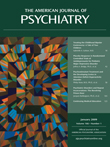To the Editor: Dr. Pomara suggests that the clinical efficacy of xanomeline treatment for improving cognitive deficits in schizophrenia patients in our study
(1) may not have been a result of sustained M
1 receptor agonist properties, as hypothesized by Dr. Lieberman et al.
(2), but rather a result of chronic agonist-induced desensitization and downregulation of cortical M
1 receptors. Although M
1 receptor desensitization contributing to the clinical efficacy of xanomeline is certainly possible, which is supported by some of the evidence cited by Dr. Pomara, such a hypothesis is difficult to test directly. On the other hand, it is equally possible that direct agonist effects of xanomeline may contribute to cognitive benefits for the following reasons.
First, the postmortem studies by Crook et al.
(3) measured 3H-pirenzapine binding, a ligand that is not a highly selective M
1 receptor antagonist and does not distinguish high versus low affinity states of the M
1 receptor. Second, muscarinic M
1 receptors appear to have a high receptor reserve requiring only a 15% occupancy to attain full signal transduction, suggesting that a significant decline in receptor number can possibly occur without causing functional consequences
(4) . Thus, the conclusion by Crook et al. that reductions in M
1 receptor density in limbic regions were a result of hypercholinergic state has not been directly tested and remains speculative.
Interestingly, preclinical testing of another M
4 receptor agonist, BuTAC, demonstrated that it possesses antipsychotic-like properties similar to xanomeline. However, unlike xanomeline, BuTAC is an antagonist at the M
1 receptor and does not exhibit efficacy in spatial learning in rats. This may support the hypothesis that the cognitive benefits of xanomeline may well be the result of its agonist properties at the M
1 receptor. Unfortunately, utilizing direct orthosteric agonists of receptors, it is difficult to conclude whether the effects of chronic administration of the drug are a result of continued agonism or desensitization of its receptors. Recently published data using muscarinic receptor potentiators further support a role for M
1 and/or M
4 positive modulation, rather than antagonism, as the primary mechanism driving antipsychotic efficacy
(5,
6) . With positive modulators, M
1 and M
4 receptors would be less sensitive to downregulation as a result of the allosteric mechanism of action. Indeed, positive allosteric modulation would be less prone to desensitization and would preserve spatial and temporal regulation of M
1 receptor activation
(4) . Therefore, based on the high receptor reserve for the M
1 receptor, and most likely for M
4 receptor, and evidence based on recent M
1 and M
4 selective positive allosteric modulators, it is unlikely that orthosteric agonist-mediated desensitization is the sole explanation for muscarinic-based mechanisms of antipsychotic therapeutics.

